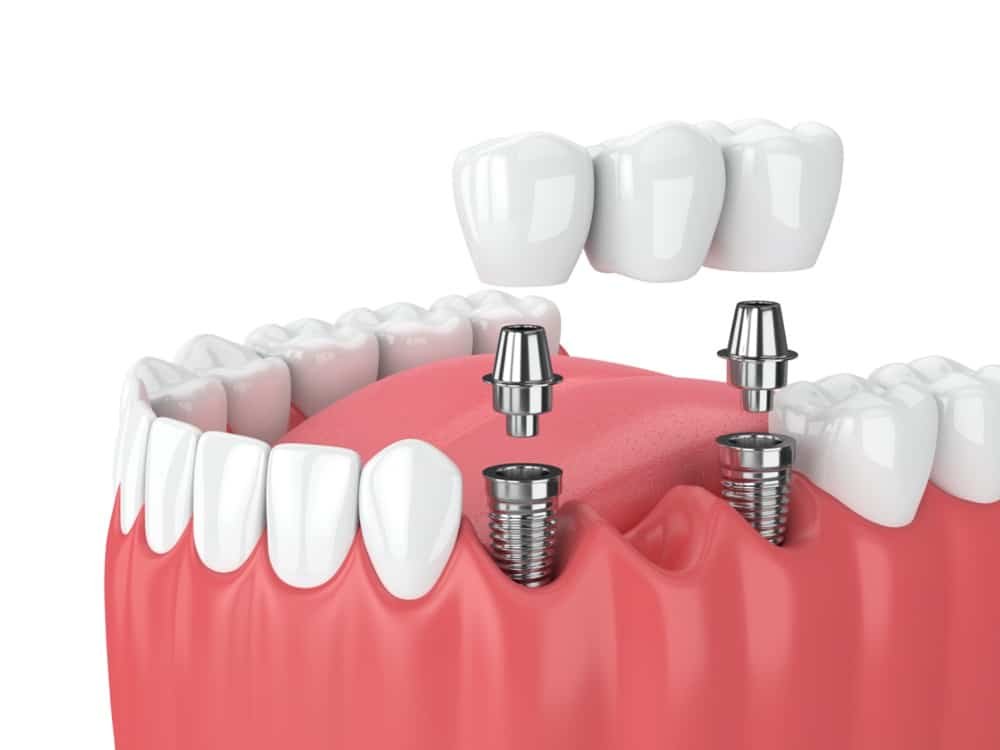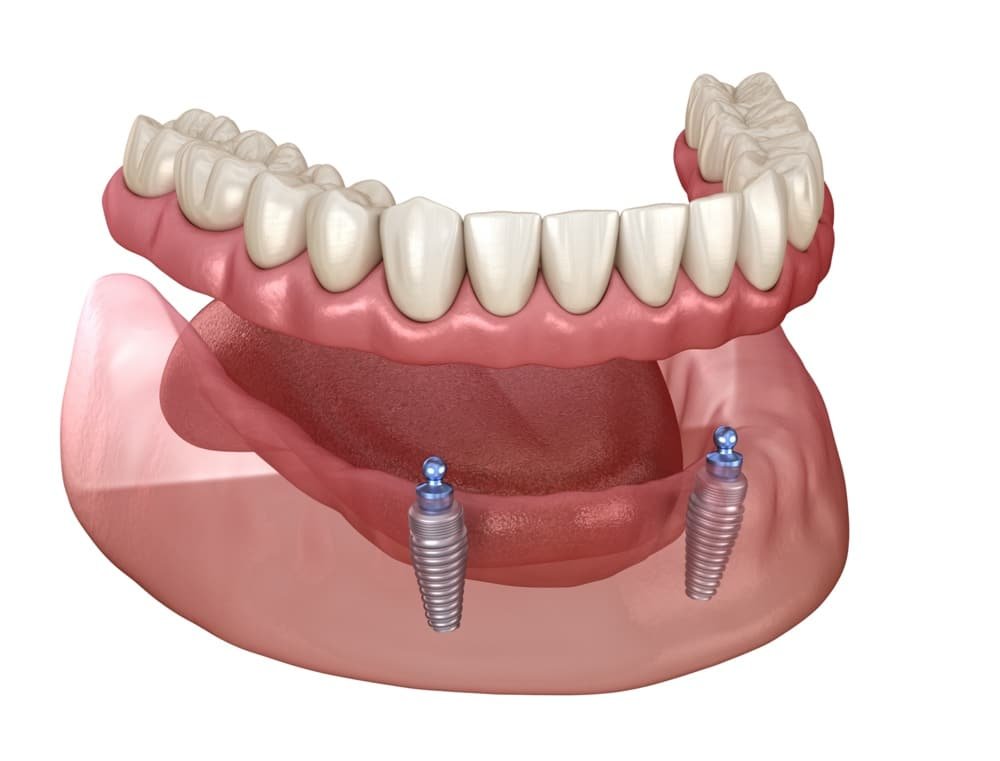
Dental implants are like artificial tooth roots. They are made of biocompatible titanium and are inserted into the jaws to support one or more missing teeth. The jaw bone grows on to the implant surface to hold it firmly in place. Dental implants are used to support crowns/bridges that are teeth which are fixed in place, or to help stabilise removable dentures. The term ‘implant’ usually refers to the titanium ‘screw’ in the jaw bone, whilst the tooth portion that is visible in the mouth is called the crown, bridge or denture. Dental implants can mimic natural teeth.

Anyone who has one or more missing teeth may be a candidate for dental implant treatment. It is a common misconception that older patients cannot enjoy the benefits of dental implants. General health is a more determining factor than age. Each patient is individually assessed and we will discuss with you whether implant treatment is appropriate in your particular case. It is important you have the information on viable alternative treatment options and we will make sure you are aware of these so that you can make an informed decision.
Implant dentistry is a very precise treatment modality and should be meticulously planned to provide the best chance of success. A detailed clinical examination is vital and this is performed in conjunction with appropriate x-rays to assess the mouth. It is often necessary to enhance the planning process by constructing a template of the ideal final tooth position and having a CT scan taken with the template in place. Modern CT scans for dental implant treatment emit significantly less radiation than conventional CT scans, but still provide excellent three-dimensional detail of the amount of bone available at the proposed implant site(s). The CT scan in conjunction with the CT scan template allows the position of a virtual implant to be evaluated and optimised prior to the implant surgery appointment. If there is a deficiency of bone for the implant screw, it is often possible to use the CT scan and template to plan the position of the implant to minimise the amount of bone grafting needed.
If the clinical examination shows there is enough bone for implant treatment then sometimes a CT scan is not needed and normal x-rays can be used to plan the optimal implant position.
If there is insufficient bone to house a dental implant then a variety of options exist to augment the bone;
Using artificial bone materials – These materials are commonly used world-wide for both dental and medical purposes to restore relatively minor deficiencies of bone. They provide a framework or scaffold for your own bone to grow into the area. Over time most of the bone material is replaced by your own bone. Usually these bone materials are placed at the same time as the insertion of the dental implant, thus avoiding a second procedure. These materials are manufactured to comply with extremely stringent safety and quality criteria for use in Europe and USA among many other countries.Most patients who require bone augmentation fall into this category.
Using donated bone – For patient with larger deficiencies of jaw bone, implant treatment is still possible and donated human bone is available to build up the implant site. Again stringent safety and quality criteria have to be met to enable the bone to be available in the UK. As the defect that needs to be augmented is relatively large if donated bone is being used, the bone build up procedure is usually performed on a separate appointment prior to implant placement. The advantage of using donated bone is that there is no need to have an additional surgical site.
Using your own bone – Bone grafts can be taken from other parts of your body and transplanted to the proposed implant site. Usually, an area of the lower jaw is used as the donor site and the surgery is performed from within the mouth so there are no external scars. Utilising your own bone means that living bone tissue is used and there is no need for the bone to undergo any processing.
Implant placement usually takes place under local anaesthesia and sterile conditions. Most patients report little or no discomfort during or after the surgery. Treatment with sedation can be arranged for complex procedures or for anxious patients.
Implant placement involves using a sequence of precise surgical instruments to create the cavity in the jaw bone into which the implant is inserted. The area is then allowed to heal and over the next few months your jaw bone will firmly unite with the implant surface. This is called osseointegration.
Dental implants enjoy very high success rates if the treatment is carried out carefully. Research shows implant success rates in the region of 90%-95%. Our own success rate is approximately 99.5%. Factors that can increase the chance of implant failure include poor oral hygiene, smoking, conditions that may affect the immune system, drugs that affect bone cells e.g bisphosphonates, and increased biting pressure. Often implant treatment can still be performed in these situations although the implant treatment protocol may need to be modified to give the best chance of a successful outcome. This will be discussed in more detail if these factors are applicable in your particular case but it is certainly important a high level of oral hygiene is attainable before considering implant treatment. Regular scaling appointments are sometimes needed prior to, and after, implant treatment. If an implant does fail it is likely the implant screw will be removed and the area allowed to heal. We will then discuss the most appropriate way to continue with treatment.

Dental implants are a very versatile way of replacing missing teeth. They can be used to replace one tooth (implant crown), several teeth (implant bridge), or all of your teeth (implant dentures or bridges). Implants are the closest to natural teeth the dental profession can currently provide. Implant crowns and bridges are fixed in place in the mouth whereas implant dentures are removable teeth whereby the implants are used to help clip the denture in place. This significantly improves the stability of the denture. Research has consistently shown the improved quality of life implant treatment can provide in terms of comfort when eating, cosmetics and restoration of oral function. One of the greatest advantages of implants over alternatives such as bridges is that a dental implant restoration does not rely on the adjacent tooth/teeth to hold it in place. Therefore, the adjacent tooth or teeth are not subjected to increased pressure or loading. Sometimes, the construction of a tooth-based bridge to replace a missing tooth necessitates cutting the adjacent (anchor) teeth into cone shapes to support the bridge. This can damage the anchor teeth. If dental implant treatment is utilised instead then there is no need to damage these teeth.
The increased stability dental implants can provide for removable denture treatment cannot be over-stated. Many patients who have lost all of their teeth in either or both jaws notice a dramatic improvement in their ability to eat after several implants have been used to help keep a new denture in place.

Although dental implants have many advantages and are often an excellent treatment option, it is important a full assessment is made to ensure they are appropriate in your particular situation. Implant treatment should be meticulously planned and only provided when the dentition is in a healthy condition. Therefore dental problems such as gum disease should be stabilised first. Implant treatment is not suitable for everybody, and conditions that affect bone healing may contraindicate dental implant treatment. At Steve Bassi Dental we pride ourselves in ensuring you are given a balanced view of the various options and their disadvantages as well as advantages. If dental implants are not suitable for you, we will ensure we inform you of this and the alternatives that are available. Sometimes there are anatomical constraints when planning implant treatment, but often there are options to overcome these.
Implant treatment, unlike alternative options such as bridges or dentures, involve a minor surgical procedure and we fully appreciate you may be apprehensive about this. However, the vast majority of patients cope with this without any form of sedation. You may experience discomfort and swelling after the implant placement appointment, which is normal and usually resolves within a few days. However, if the area is not kept sufficiently clean then the tissues where the implant has been placed may become infected and this can cause the pain and swelling to worsen. It is therefore extremely important you follow all the instruction that are provided to maintain a healthy oral environment.
As mentioned previously, implant treatment (just like the other treatment we provide) should be carefully planned and performed. Where there are teeth next to the proposed implant site, there is a risk they can be damaged during the procedure. Meticulous planning and care during implant treatment can minimise this risk. Very rarely, the jaw bone does not heal around a dental implant and this is termed failure of osseo-integration. If this occurs then the implant has to be removed, which is normally a simple process, and the area allowed to heal before deciding what to do next. Usually it is possible to place a new implant after the healing process has finished or you may decide to proceed with an alternative treatment plan. We would like to emphasise it is extremely rare for implants to be unsuccessful in this way.
Just like most forms of dental treatment, dental implants require a degree of maintenance to give them the best chance of providing long-term function. It is extremely important the oral hygiene is optimal and a cleaning routine is developed to remove any plaque and tartar deposits on a daily basis. There are numerous cleaning aids available including interdental brushes, superfloss and water irrigators as well as traditional manual/electric toothbrushes and floss/tape. You will be advised on the most suitable method in your particular situation, and you will have a number of follow-up appointments to monitor the effectiveness of your cleaning routine. It is also normally necessary to scale the implants and teeth periodically to ensure there is no accumulation of plaque and tartar. Appointments will be scheduled to assess the implant restorations, usually once or twice a year and these are in addition to your regular dental check-ups by your own dentist.